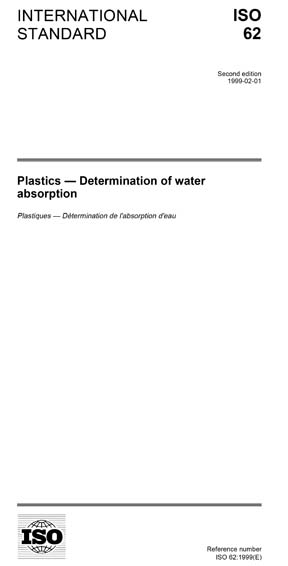Historical
ISO 62:1999
Plastics - Determination of water absorption
This International Standard describes a procedure for determining the moisture absorption properties in the “through-the-thickness” direction of flat or curved-form solid plastics. This International Standard also describes procedures for determining the amount of water absorbed by plastic specimens of defined dimensions, when immersed in water or when subjected to humid air under controlled conditions. The “through-the-thickness” moisture diffusion coefficient can be determined for single-phase material by assuming Fickian diffusion behaviour with constant moisture absorption properties through the thickness of the test specimen. This model is valid for homogeneous materials and for reinforced polymer-matrix composites tested below their glass transition temperature. However, some two-phase matrices such as hardened epoxies may require a multi-phase absorption model which is not covered by this International Standard.
Ideally the best comparison of the water absorption properties and/or diffusion coefficients of materials should be carried out only using the equilibrium moisture content of plastics exposed to identical conditions. The comparison of materials using properties at moisture equilibrium does not assume, and is therefore not limited to, single-phase Fickian diffusion behaviour.
Alternatively, water absorption of plastic specimens of defined dimensions exposed to immersion or humidity under controlled conditions but for an arbitrary time period can be used to compare different batches of the same material or for quality control tests of a given material. For this type of comparison, it is essential that all test specimens be of identical dimensions and, as nearly as possible, have the same physical attributes, e.g. surface smoothness, internal stresses, etc. However, moisture equilibrium is not reached under these conditions. Therefore, results from this type of test cannot be used to compare the water absorption properties of different types of plastics. For the more reliable results, simultaneous tests are recommended.
The results obtained using the methods described in this International Standard are applicable to most plastics but are not applicable to cellular plastics, granulates, or powders which can show additional absorption and capillary effects. Plastics exposed to moisture under controlled conditions for defined periods of time provide relative comparisons between them. The tests described for determination of diffusion coefficient may not be applicable to all plastics. Plastics that cannot retain their shape when immersed in boiling water should not be compared using method 2 in 6.3.
International Organization for Standardization [iso]


